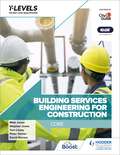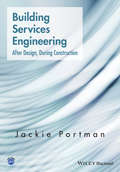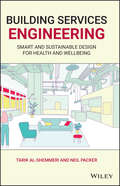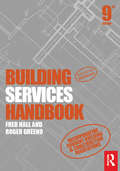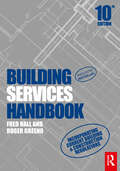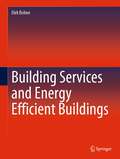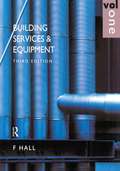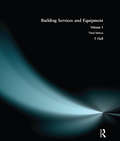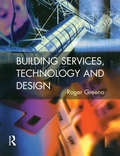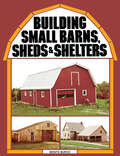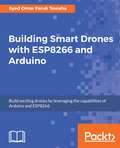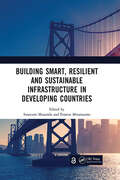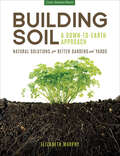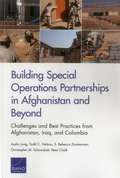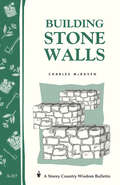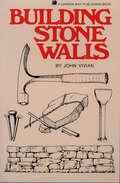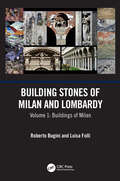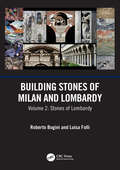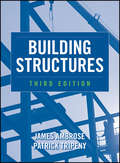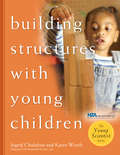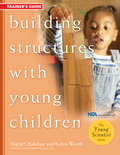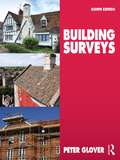- Table View
- List View
Building Services Engineering for Construction T Level: Core
by Stephen Jones Mike Jones Peter Tanner Tom Leahy David WarrenTackle the core component of your T Level with this comprehensive resource published in association with City & Guilds.With topic coverage ranging from the principles of construction science and design to workplace relationship management, this book provides complete coverage of the Building Services Engineering for Construction qualification's core units and will equip you with the skills you need to shape your career.- Break down complex topics with summary tables and hundreds of images and artworks- Apply your knowledge in real-world case studies and discover some of the dilemmas you can expect to face in the workplace- Re-cap knowledge and understanding with 'Key terms' and 'Test yourself' features, as well as a detailed glossary- Prepare for your exams and the employer-set project using practice questions and project practice exercises- Develop the functional skills you need to thrive in the industry with English and maths exercises- Understand how to avoid hazards and minimise risk with regular health and safety reminders- Hone core skills with expert authors Mike Jones, Stephen Jones, Tom Leahy, Peter Tanner and David Warren, who draw on their extensive teaching and industry experience
Building Services Engineering: After Design, During Construction
by Jackie PortmanBuilding Services Engineering focuses on how the design-construction interface and how the design intent is handled through the construction stage to handover and in the short term thereafter.Part One sets the scene by describing the stakeholders involved in the construction stage and the project management context.Part Two focuses specifically on the potential roles and responsibilities of building services engineers during construction and post-construction.
Building Services Engineering: Smart and Sustainable Design for Health and Wellbeing
by Tarik Al-Shemmeri Neil PackerBuilding Services Engineering: Smart and Sustainable Design for Health and Wellbeing covers the design practices of existing engineering building services and how these traditional methods integrate with newer, smarter developments. These new developments include areas such as smart ventilation, smart glazing systems, smart batteries, smart lighting, smart soundproofing, smart sensors and meters. Combined, these all amount to a healthier lifestyle for the people living within these indoor climates. With over one hundred fully worked examples and tutorial questions, Building Services Engineering: Smart and Sustainable Design for Health and Wellbeing encourages the reader to consider sustainable alternatives within their buildings in order to create a healthier environment for users.
Building Services Handbook
by Roger Greeno Fred HallThe ninth edition of Hall and Greeno's leading textbook has been reviewed and updated in relation to the latest building and water regulations, new technology, and new legislation. For this edition, new updates includes: the reappraisal of CO2 emissions targets, updates to sections on ventilation, fuel, A/C, refrigeration, water supply, electricity and power supply, sprinkler systems, and much more. Building Services Handbook summarises the application of all common elements of building services practice, technique and procedure, to provide an essential information resource for students as well as practitioners working in building services, building management and the facilities administration and maintenance sectors of the construction industry. Information is presented in the highly illustrated and accessible style of the best-selling companion title Building Construction Handbook. THE comprehensive reference for all construction and building services students, Building Services Handbook is ideal for a wide range of courses including NVQ and BTEC National through Higher National Certificate and Diploma to Foundation and three-year Degree level. The clear illustrations and complementary references to industry Standards combine essential guidance with a resource base for further reading and development of specific topics.
Building Services Handbook
by Roger Greeno Fred HallThe tenth edition of Hall and Greeno's leading textbook has been reviewed and updated in relation to the latest building, wiring and water regulations, new technology and new legislation. For this edition, new updates include electric vehicle charging, overheating in buildings, waste water treatment, energy performance certification, mechanical ventilation, food waste recycling, electro-magnetic lifts, biogas processing and much more. Building Services Handbook summarises the application of all common elements of building services practice, technique and procedure to provide an essential information resource for students as well as practitioners working in building services, building management and the facilities administration and maintenance sectors of the construction industry. Information is presented in a highly illustrated and accessible style. The comprehensive reference for all construction and building services students, Building Services Handbook is ideal for a wide range of courses including T Level, NVQ and BTEC National through Higher National Certificate and Diploma to Foundation and three-year Degree level. The clear illustrations and complementary references to industry Standards combine essential guidance with a resource base for further reading and development of specific topics.
Building Services Procurement
by Christopher MarshProcurers and contractors increasingly need practical guidance for the strategic procurement of building services. Clients seeking to improve the delivery performance of the construction industry are increasingly using alternative procurement arrangements. These modern arrangements attempt to deliver a more strategic approach to achieving value for money. Yet little thought is ever given to the strategic importance of building services. No other single aspect of a project will affect project success more than the timely delivery of a fully functioning services installation. Beyond the normal considerations of time, cost and quality, building services have a series of unique requirements not normally considered. For the first time these unique requirements are combined in a single text, providing the reader with the definitive guide to building services procurement. The text reviews each of the major critical success factors and clearly explains the supporting processes that must be enacted to ensure success. It reviews the general nature of procurement systems and construction projects, and then explores the increasing importance that building services play both in the construction process and in determining success for the client. Each significant stage within the procurement process is explored by explaining its importance and showing what decisions need to be made to develop a cohesive strategy. It concludes by giving a step-by-step guide to clearly develop and implement a building services procurement strategy.
Building Services and Energy Efficient Buildings
by Dirk BohneAuf dem neuesten “Stand der Technik” präsentiert sich das Buch noch übersichtlicher mit einer neu gegliederten, äußerst benutzerfreundlichen Darbietung des Stoffes. Das Fachwissen wurde dabei konzentriert und komprimiert auf die für Architekten und Bauingenieure relevanten Sachverhalte und Zusammenhänge. Komplett neu gestaltet wurde der umfangreiche Abbildungsteil mit hochwertigen Zeichnungen zur bildhaften Kommentierung des Textes. Um im Technischen Ausbau mit der technologischen Entwicklung, den steigenden Komfortansprüchen und den Erfordernissen eines wirtschaftlichen und umweltfreundlichen Umgangs mit der Energie Schritt zu halten, ist der “Wellpott/ Bohne” weiterhin ein unverzichtbares Grundlagenbuch.
Building Services and Equipment: Volume 1
by F. HallServices and equipment in complex modern buildings account for over one-third of the total cost. Therefore study of services and equipment is essential for technicians in construction, surveying and architecture.Building Services and Equipment Volume 1 is the first book in a widely acclaimed trilogy that has become established as the leading work in this field. This volume deals with the topics of fuel conservation and thermal comfort by use of integrated heating, ventilating, air conditioning and lighting systems, district heating, thermal insulation, heat pumps and thermostatic controls.
Building Services and Equipment: Volume 2
by Frederick E HallA widely acclaimed trilogy that has become established as the leading work in this field as well as taking account of current Building Regulations, Codes of Practice and recent technological advances. Special attention has been paid to the reduction of fuel costs and environmental factors.This volume covers pipe-sizing for hot and cold water installations, fine control systems, fire detactor systems, lifts and escalators, service ducts, burglar alarms, gas and electricity supply, daylighting and artificial light
Building Services and Equipment: Volume 3
by F. HallA widely acclaimed trilogy that has become established as the leading work in this field. As well as taking account of current Building Regulations, Codes of Practice and recent technological advances. Special attention has been paid to the reduction of fuel costs and environmental factors.This volume covers the essential design calculations for pipe-sizing, drainage, electrical installations, thermal problems, ventillation and air conditioning, gas installations, lighting and solar heating.
Building Services, Technology and Design (Chartered Institute of Building)
by Roger GreenoBuilding Services, Technology and Design provides a concise guide to the installation and design of principal services in domestic and commercial buildings. It covers the level 2 module of The CIOB's Education Framework and is officially sanctioned by the CIOB as the recognised text for that module. The book combines theory, design and application in one volume and is supported throughout with illustrations, design examples, tables and charts.Services covered include: cold and hot water; heating; ventilation; air conditioning; gas; electricity; security; fire control; sanitation; drainage and transport systems.Building Services, Technology and Design is a core text for the CIOB level 2 module, as well as BTEC HNC/D building studies and degree courses in building. It is also an essential reference for all members of the facilities management and construction industry.
Building Small Barns, Sheds & Shelters
by Monte BurchBuild your own outbuildings and enjoy the space to do more of what you love. From simple toolsheds and animal shelters to smokehouses and low-cost barns, Monte Burch guides you through everything you need to know to make your small building projects a reality. Detailed blueprints, easy-to-follow instructions, and expert advice are suited to even the first-time builder. Discover how easy it is to create your own customized spaces that will allow your passions to grow.
Building Smart Drones with ESP8266 and Arduino: Build Exciting Drones By Leveraging The Capabilities Of Arduino And Esp8266
by Packt Publishing<P><P>Leverage the WiFi chip to build exciting Quadcopters <P><P>Key Features <P><P>Learn to create a fully functional Drone with Arduino and ESP8266 and their modified versions of hardware. <P><P>Enhance your drone's functionalities by implementing smart features. <P><P>A project-based guide that will get you developing next-level drones to help you monitor a particular area with mobile-like devices. <P><P>Book Description <P><P>With the use of drones, DIY projects have taken off. Programmers are rapidly moving from traditional application programming to developing exciting multi-utility projects. This book will teach you to build industry-level drones with Arduino and ESP8266 and their modified versions of hardware. <P><P>With this book, you will explore techniques for leveraging the tiny WiFi chip to enhance your drone and control it over a mobile phone. This book will start with teaching you how to solve problems while building your own WiFi controlled Arduino based drone. You will also learn how to build a Quadcopter and a mission critical drone. Moving on you will learn how to build a prototype drone that will be given a mission to complete which it will do it itself. You will also learn to build various exciting projects such as gliding and racing drones. By the end of this book you will learn how to maintain and troubleshoot your drone. <P><P>By the end of this book, you will have learned to build drones using ESP8266 and Arduino and leverage their functionalities to the fullest. <P><P>What you will learn <P><P>Includes a number of projects that utilize different ESP8266 and Arduino capabilities, while interfacing with external hardware <P><P>Covers electrical engineering and programming concepts, interfacing with the World through analog and digital sensors, communicating with a computer and other devices, and internet connectivity <P><P>Control and fly your quadcopter, taking into account weather conditions <P><P>Build a drone that can follow the user wherever he/she goes <P><P>Build a mission-control drone and learn how to use it effectively <P><P>Maintain your vehicle as much as possible and repair it whenever required <P><P>Who This Book Is For <P><P>If you are a programmer or a DIY enthusiast and keen to create a fully functional drone with Arduino and ESP8266, then this book is for you. Basic skills in electronics and programming would be beneficial. This book is not for the beginners as it includes lots of ideas not detailed how you can do that. If you are a beginner, then you might get lost here. The prerequisites of the book include a good knowledge of Arduino, electronics, programming in C or C++ and lots of interest in creating things out of nothing.
Building Smart, Resilient and Sustainable Infrastructure in Developing Countries: Proceedings of the 8th International Conference on Development and Investment in Infrastructure (DII-2022, Johannesburg, South Africa, 6–7 October 2022)
by Innocent MusondaBuilding Smart, Resilient and Sustainable Infrastructure in Developing Countries contains the papers presented at the International Conference on Development and Investment in Infrastructure (DII-2022). The contributions cover a wide range of topics related to infrastructure issues on the African continent: Sustainable Infrastructure Development Smart Infrastructure and Cities Quality and Resilient Infrastructure Education, Empowerment, Gender Equity, Wellness and Development Environmental and Waste Management/Facilities & Real-Estate Management Infrastructure, Investment and Finance- Trends and Forecasts Infrastructure: Shock Events, Procurement, Project Management, Health & Safety Infrastructure: Economic, Social/Environmental Sustainability Digital Innovation and transition in the built environment Building Smart, Resilient and Sustainable Infrastructure in Developing Countries evaluates innovations, empowerment, growth and sustainable development of infrastructure development in Africa, and aims at administrators, academics, and professionals.
Building Soil: Natural Solutions for Better Gardens and Yards
by Elizabeth MurphyA down-to-earth, complete manual for achieving great gardening results with your own rich, organic soil.All the secrets to rich, sustainable soil are revealed to you. You’ll be amazed how easy it is to improve your garden or yard when you begin at ground level.Even experienced gardeners can be intimidated by soil. It isn’t just the soil-testing data and all the big words, like vermicompositing and mycorrhizal fungi. It’s also the fact that when you begin to work with the soil, you’re working with the very earth you grow in; you don’t want to make any mistakes. But with Building Soil as your guide, you can achieve your goal of rich, sustainable soil without the fear.Building Soil: A Down-to-Earth Approach is rich with practical, up-to-date information on how to grow and maintain healthy soils. Simple methods perfect for the home gardener’s use put healthy, organic soil within everyone’s reach. Because it’s written in plain language, you don’t need a degree in soil management to understand this book—you only need a yard or garden and the desire to improve it at the most basic level. By following author Elizabeth Murphy’s detailed instructions, you can become a successful soil-based gardener, whether you want to start a garden from scratch or improve an existing plot.Less weeding & laborLess water waste100% natural
Building Special Operations Partnerships in Afghanistan and Beyond: Challenges and Best Practices from Afghanistan, Iraq, and Colombia
by Peter Chalk Austin Long Todd C. Helmus S. Rebecca Zimmerman Christopher M. SchnaubeltBuilding the capacity of Afghan special operations forces (SOF) is a key goal of the United States and its coalition partners. This report summarizes key partnering practices and presents findings from SOF partnership case studies in Afghanistan, Iraq, and Colombia. The goal is to identify best practices to benefit the development of Afghan SOF, as well as for special operations partnerships beyond Afghanistan.
Building Stone Walls: Storey's Country Wisdom Bulletin A-217
by Charles McRavenSince 1973, Storey's Country Wisdom Bulletins have offered practical, hands-on instructions designed to help readers master dozens of country living skills quickly and easily. There are now more than 170 titles in this series, and their remarkable popularity reflects the common desire of country and city dwellers alike to cultivate personal independence in everyday life.
Building Stone Walls: Storey's Country Wisdom Bulletin A-217
by John VivianRustic and charming or stately and proud, a well-built stone wall can add personality and beauty to your property. John Vivian’s lively approach and step-by-step instructions encourage you to transform a pile of rocks into an enduring landscape feature with gates, retaining walls, or stiles to suit your needs. Whatever unique challenges come with your site — poor drainage, sloping ground, or low-quality rubble material — Vivian offers innovative designs and reproducible methods to help you build a beautiful, long-lasting wall.
Building Stones of Milan and Lombardy: Volume 1: Buildings of Milan
by Roberto Bugini Luisa FolliMilan has played an important role in the Italian country since the Roman period. This importance is reflected also by the diffusion of stone architecture: a persisting trait of Milan architecture was the use of different stones in the same building. Milan lies in the middle of the alluvial plain of the Po, far from the stone quarries; some waterways were dug out in order to supply the building stones from the surrounding territories. The study of stone as a building material was significant at the end of 19th century, but then it was largely neglected by both architects and geologists. So it is significant to suggest a study about the stones employed to build in Milan (Volume 1) in relationship with a petrographic study about the features of the stones quarried in the whole Lombard territory (Volume 2). The present volume contains a record of Milanese edifices marking the different historical periods. Each edifice is described in a "card" containing: the building history, the architect, the kind of stone employed and subdivided according to the different parts of the building and the shape of stone elements. A particular investigation is addressed to the stones used during the 20th century; a great part of them were never used before in Milan (or in Lombardy).
Building Stones of Milan and Lombardy: Volume 2: Stones of Lombardy
by Roberto Bugini Luisa FolliMilan and Lombardy have played an important role in the Italian country since the Roman period. This importance is reflected also by the diffusion of stone architecture: a persisting trait of Milan architecture was the use of different stones in the same building. Milan lies in the middle of the alluvial plain of the Po, far from the stone quarries; some waterways were dug out in order to supply the building stones from the surrounding territories. The study of stone as building material was significant at the end of 19th century, but then it was largely neglected by both architects and geologists. So it is significant to suggest a study about the stones employed to build in Milan (Volume 1) in relationship with a petrographic study about the features of the stones quarried in the whole Lombard territory (Volume 2). Volume 2 contains the description of the features of the stones reported in Volume 1. These features include metamorphic and magmatic rocks of the Alpine area; sedimentary rocks and loose materials of the Prealpine area; sedimentary rocks of the Apennine area; and loose sediments of the Padania plain. Some stones, coming from other northern Italian regions, and used in Lombard architecture, are also described. Each stone is described in a "card" containing commercial and historical names, petrographic classification, macroscopic features, mineralogical composition, microscopic features, geological setting, quarry sites, transport to yards, morphology of dressed elements and surface handworking, use in architecture in the whole Lombard territory and abroad and decay morphologies. A particular investigation is addressed to the stones used during the 20th century; a great part of them were never used before in Milan and in Lombardy.
Building Structures
by James Ambrose Patrick TripenyThe comprehensive reference on the basics of structural analysis and design, now updated with the latest considerations of building technology Structural design is an essential element of the building process, yet one of the most difficult to learn. While structural engineers do the detailed consulting work for a building project, architects need to know enough structural theory and analysis to design a building. Most texts on structures for architects focus narrowly on the mathematical analysis of isolated structural components, yet Building Structures looks at the general concepts with selected computations to understand the role of the structure as a building subsystem-without the complicated mathematics. New to this edition is a complete discussion of the LRFD method of design, supplemented by the ASD method, in addition to: The fundamentals of structural analysis and design for architects A glossary, exercise problems, and a companion website and instructor's manual Material ideally suited for preparing for the ARE exam Profusely illustrated throughout with drawings and photographs, and including new case studies, Building Structures, Third Edition is perfect for nonengineers to understand and visualize structural design.
Building Structures with Young Children
by Karen Worth Ingrid ChalufourFrom playground equipment to skyscrapers, structures are everywhere. The second unit in the Young Scientist series, Building Structures with Young Children guides children's explorations to help deepen their understanding of the physical science present in building block structures--including concepts such as gravity, stability, and balance. Looking at science in a new way, this nationally field-tested curriculum supports the early development of important science inquiry skills such as questioning, investigating, discussing, and formulating ideas and theories.
Building Structures with Young Children--Trainer's Guide
by Karen Worth Ingrid ChalufourA companion to the curriculum, this trainer's guide serves as an indispensable handbook for trainers and administrators interested in introducing staff to the Building Structures with Young Children curriculum--from planning to implementation. Special sections outline the curriculum and introduce scientific reasoning to adults, and eight workshops detail the complete curriculum for staff members. The guide also includes strategies for supporting teachers over time through mentoring and guided discussions.
Building Surveyor’s Pocket Book (Routledge Pocket Books)
by Melanie Smith Christopher GorseBuilding Surveyor’s Pocket Book is an accessible encyclopaedia of matters vital to building surveyors. Well-illustrated with diagrams, pictures, tables, and graphs, it covers all essential elements of building pathology, building performance, and building construction terminology in a simple, accessible way for the practitioner and student. This Pocket Book provides a practical and portable reference text, working as a first-stop publication for those wishing to refresh their knowledge or in need of guidance on surveying practice. Working through fundamental principles in key practice areas, the book is not overly bound by the regulation and legislation of one region, and the principles can be applied internationally. This book is ideal reading for individual surveyors, practitioners, and students in building surveying, facilities management, refurbishment, maintenance, renovation, and services management. It is also of use for those interested in building forensics, building performance, pathology, and anyone studying for their RICS APC. Many other professions in architecture, contracting, engineering, and safety will also find the book of use when undertaking similar practice.
Building Surveys
by Peter GloverBuilding Surveys has been a trusted guide for both students and professionals for over 30 years, evolving throughout its eight editions to address the challenges and responsibilities of the building surveying role. It covers everything needed for initial inspections such as equipment, know-how and procedures to writing an accurate report, making it indispensable to those practicing in or studying this field. This updated eighth edition features new material on modern methods of construction, and the drive for green homes. Essential reading for building construction students, professional surveyors, and others who may be required to inspect and report on buildings. Illustrated throughout with colour photos showing examples of building defects in full detail. All the structural aspects of property surveying are explained, covering foundations, walls and roofs as well as what to look out for, and how to deal with problems. Materials and techniques no longer in use are covered as well as new technologies, so the reader is prepared for anything they might encounter. Legal considerations and recent cases are also used to illustrate good working practice, making this an extremely practical companion to the subject.
